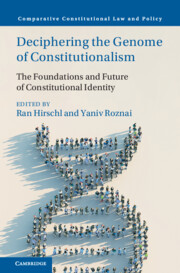Book contents
- Deciphering the Genome of Constitutionalism
- Comparative Constitutional Law and Policy
- Deciphering the Genome of Constitutionalism
- Copyright page
- Contents
- Figures
- Contributors
- Preface
- Acknowledgments
- Introduction
- Part I Foundations, Theory, and Concepts
- Part II Comparative Perspectives
- Part III American Constitutionalism and Constitutional Identity
- Part IV Emerging Trends
- 19 Constitution Making and Disharmonic Identity
- 20 Constitutional Identity and Unamendability
- 21 Illiberal Constitutionalism and the Abuse of Constitutional Identity
- 22 Deconstructing Constitutional Identity in Light of the Turn to Populism
- 23 Unconstitutional Constitutional Identities in The European Union
- 24 What Counts as Constitutional Identity?
- 25 Contrariness and Contradiction in Constitutional Law
- 26 Conclusion
- Index
- References
24 - What Counts as Constitutional Identity?
from Part IV - Emerging Trends
Published online by Cambridge University Press: 14 March 2024
- Deciphering the Genome of Constitutionalism
- Comparative Constitutional Law and Policy
- Deciphering the Genome of Constitutionalism
- Copyright page
- Contents
- Figures
- Contributors
- Preface
- Acknowledgments
- Introduction
- Part I Foundations, Theory, and Concepts
- Part II Comparative Perspectives
- Part III American Constitutionalism and Constitutional Identity
- Part IV Emerging Trends
- 19 Constitution Making and Disharmonic Identity
- 20 Constitutional Identity and Unamendability
- 21 Illiberal Constitutionalism and the Abuse of Constitutional Identity
- 22 Deconstructing Constitutional Identity in Light of the Turn to Populism
- 23 Unconstitutional Constitutional Identities in The European Union
- 24 What Counts as Constitutional Identity?
- 25 Contrariness and Contradiction in Constitutional Law
- 26 Conclusion
- Index
- References
Summary
This chapter reflects on whether and how large-N empirical studies can help our understanding of constitutional identity. It argues that although we cannot simply count and measure many aspects of constitutional identity, empirical analysis can help us better understand the concept and offers some practical suggestions for how it can do so. Next, it presents original data from nationally representative surveys conducted in five countries (the United States, Japan, China, South Korea, and Taiwan) and analyzes respondents’ responses to whether they feel represented by the constitution. The main finding from this exercise is that respondents who are older, male, higher-educated and have high incomes feel more represented than younger, female, lower-educated, and low-income respondents. In essence, groups that are relatively well off in society believe that their values and interests are better represented by the constitution than those who are less well off. While it does not directly tell us what the constitution’s identity is, these data do tell us something about the nature of the relationship between the constitution and those governed by it. Notably, they are consistent with accounts that suggest that constitutions reflect elite interests.
- Type
- Chapter
- Information
- Deciphering the Genome of ConstitutionalismThe Foundations and Future of Constitutional Identity, pp. 312 - 329Publisher: Cambridge University PressPrint publication year: 2024

